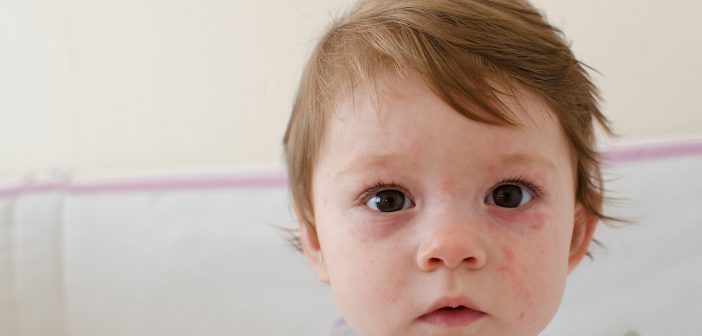Rashes are a common occurrence in kids. From simple heat rash or nappy rash to more serious skin conditions like eczema, no kid gets through childhood rash-free.
However, there are some more notable rashes that are caused by viruses and bacterial infections that all parents should be aware of.
Here are 5 to keep an eye out for:
1. Hand Foot and Mouth Disease
What causes it?
A virus – from a group of viruses called enteroviruses, usually the coxsackie A virus.
What does it look like?
- Small blister-like lesions inside mouth, on palms of hands and soles of feet.
- Possibly also on knees, elbows and nappy area.
Other symptoms
- Mild Fever (appears first)
- Runny Nose
- Sore throat and mouth
Treatment
- No specific treatment other than pain relief, such as paracetamol, for fever and discomfort.
How is it spread?
- Contact with blisters –last 3-5 days but are no longer infectious after they have crusted over.
- Nose & throat secretions – through sneezing, coughing etc.
- Faeces – still infectious several weeks after person has recovered.
- Common in places of close contact such as child care centres.
- Incubation period is 4-6 days.
2. Impetigo (School Sores)
What causes it?
A bacteria infection – from bacteria such as Streptococcus A or Staphylococcus aureus
What does it look like?
- Flat red spots or small blisters, common on face, hands and legs.
- Spots may be filled with pus and have a crust once burst.
- Untreated, sores can get bigger.
Other symptoms
- Itching or soreness
Treatment
- Antibiotic medicine/ointment
- Covering sores with watertight dressings to avoid scratching and spread of infection.
How is it spread?
- When an existing sore gets infected by a particular bacteria.
- Impetigo is highly contagious both spreading sores on the child and to other children.

3. Molluscum Contagiosum
What causes it?
A virus – Molluscum Contagiosum Virus (MCV)
What does it look like?
- Small, raised lumps with a dent in the middle that look similar to pimples or warts.
- Will have a core that looks cheesey/waxy.
- The lumps can be pink or pearl-coloured and are usually small.
- Rash can last months or years and can spread to other parts of the body.
Other symptoms
- Itching /dermatitis
Treatment
- No formal treatment
- Some get lumps frozen off as they can last a long time
- Dermatitis creams to ease itching
- Prevention of spreading spots to other parts of the body including covering them to avoid scratching.
How is it spread?
- Contact, including infected items such as towels or even bath or pool water.
- Incubation period of virus can be up to 2 months.
- Common in warm, moist weather.
4. Scarlet Fever
What causes it?
A bacterial infection – Streptococcus (Group A)
What does it look like?
- Tiny red spots, similar to sunburn.
- Usually rough and bumpy, like sandpaper.
- Also may turn tongue red.
Other symptoms
- Sore throat
- Swollen lymph nodes
- High fever
- Vomiting
Treatment
- Antibiotics
How is it spread?
- Contact, sneezing or coughing.
- Infectious period 1-2 days if treated.
- Can last much longer if not treated.
5. Slapped cheek disease (Fifth syndrome)
What causes it?
A virus – parvovirus B19
What does it look like?
- A blotchy rash that starts on face then starts to look more lacy as it fades.
- Rash will also spread to torso, back, arms and legs.
- Rash may take 1-3 weeks to clear and may come and go.
- By the time rash has appeared child is usually no longer sick or contagious.
Other symptoms
- Fever (appears first)
- Headache
- Runny nose
- Joint swelling or pain (older children)
Treatment
- Rest and pain relief, if necessary.
How is it spread?
- Contact, coughing or sneezing.
- Incubation period of virus is about 2 weeks, is when children are most contagious.
Remember that antibiotics will only work on bacterial infections, not viruses.
Of course, there are many more sinister childhood illnesses that involve a rash, such as meningococcal, chicken pox, measles and more. If your child has a rash that concerns you, don’t hesitate to see your GP.

